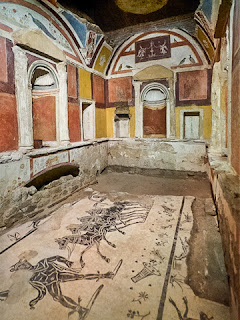The Excavations of St. Peter’s
Cathedral in Rome
Nero Augustus Caesar had St. Peter,
the apostle of Jesus Christ and whom Catholics recognize as the first Pope,
crucified in his Circus (race track) that he had built where the Vatican stands
today. After the crucifixion, St. Peter’s followers buried him in a nearby
hillside necropolis, a city of the dead. It was a place fashioned to look like
a city in miniature. Wealthy pagan families entombed their dead in houses where
they could continue their new lives.
Some two hundred years later, the
Roman Emperor Constantine became a Christian and, in the fourth century,
ordered the construction of a church over the tomb of St. Peter. He had the
roofs of all of the mausoleums removed and filled them and the streets with
soil; thereby, creating a flat surface on which to build. A thousand years later, the Catholics
dismantled the original church, leaving the floor, and built the present St.
Peter’s Basilica. It sits above the floor of the original church. Thus they built
the “new” Basilica without any systematic excavation of what lie underneath.
Consequently, the graveyard remained untouched since the time of Constantine.
Beneath the main floor of the present church is the catacomb of the Popes, the
floor of which is of the original building. Tourist can freely visit this area.
The primary artist involved in the
designing of the Basilica was Donato Bramante, who died on the eleventh of
March 1514. After his death, a number of architects continued his work;
however, the Vatican later commissioned Michelangelo to complete it. He designed most of the apses and
the main dome before dying.
Domenico Fontana completed the dome in 1589. Its dedication was in 1593.
As the centuries passed, so did the
memory of the necropolis beneath the Basilica. In 1939 workers digging a tomb
for the deceased Pope Pius XI, broke through a wall beneath the church and
rediscovered this small city of the dead. Pope Pius XII ordered the excavation,
but kept the work secret in case they didn’t find St. Peter’s tomb. Since the
necropolis acts as the foundation for St. Peter’s Basilica, the entire area
could not be uncovered without the possibility of having the Basilica
experience damage. Work continued for a decade and on the twenty-third of
December 1950, Pope Pius XII announced the discovery of St. Peter’s tomb.
On the twenty-sixth of June 1968,
Pope Paul VI announced that they discovered the remains of St. Peter. His
remains are encased in an altar-shrine (The Trophy of Gaius) built sometime
around 200 AD.
Amid the fragments of St. Peter’s
bones, the skull, vertebrae, arms, hands, pelvis, and legs, there is nothing
from the ankles down. Theory has it that if a man was crucified upside down, as
tradition says Peter was, the easiest way to remove what was left of his body would have been to chop off the feet and
remove the rest of the corpse from the cross. I doubt his followers did
that. Most likely the assistants to the persecutions did it.
I
Scavi, pronounced ee scahvee, are the Italian plural words meaning the excavations. Public tours are available; however, in order
to visit these excavations reservations are necessary and need to be made
months in advance of one’s visit and can be made via the internet. When one
tours I Scavi it is an exceptional
visit back in time to when one can “feel” the presence of those who may have
been the followers of Christ. A walk through them is a walk into some important
truths concerning early Christianity. Information is also available under the
subject of the Trophy of Gaius.
On my visit, I was able to get a
distant view of Gaius Trophy, which contain St. Peter’s relics. I say distant
since, the closest they allow you to approach is about twenty feet. Because of
the other tombs, it is not a very good see. Nevertheless, there is a light over
the trophy which helps in viewing. The tour is intriguing since you walk along
narrow passage ways past the facades of tombs. A guide leads the way while you
listen to a hand held electronic device describing in selective language what
you are viewing. For more photos go to www.holidaze.com, www.culturaltravelguide.com ..under
St. Peter’s Basilica,





No comments:
Post a Comment